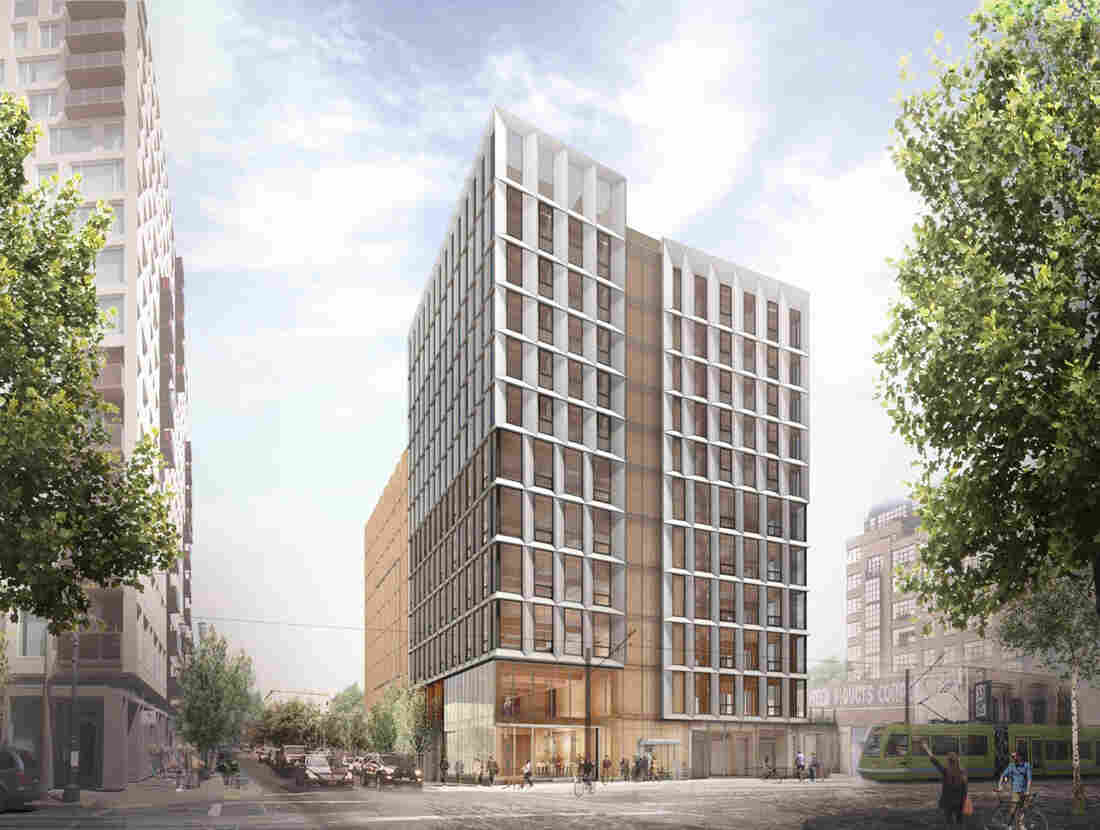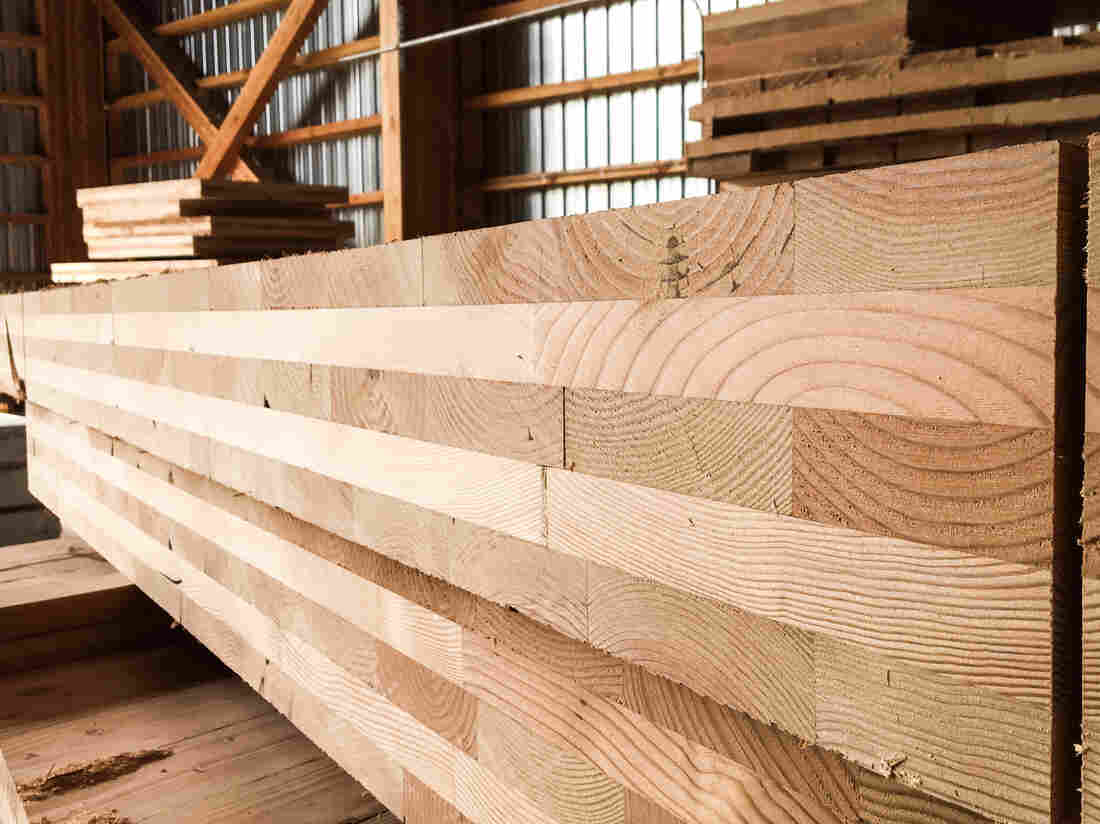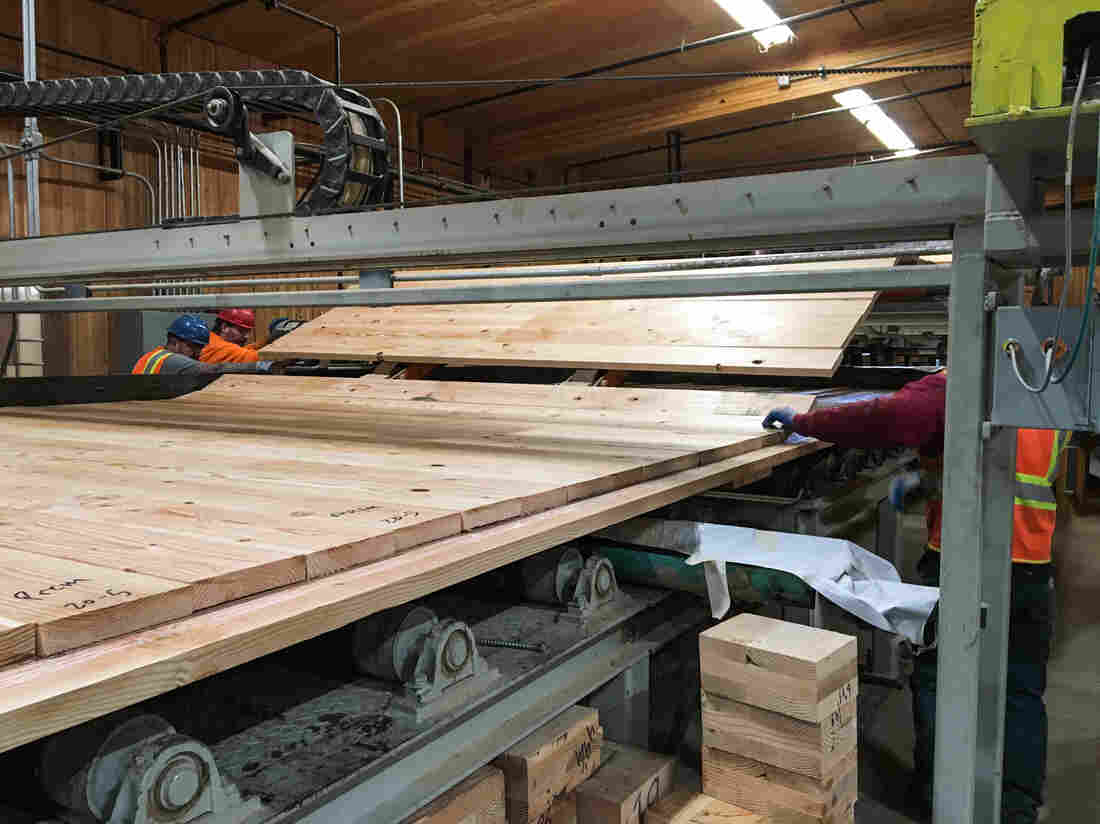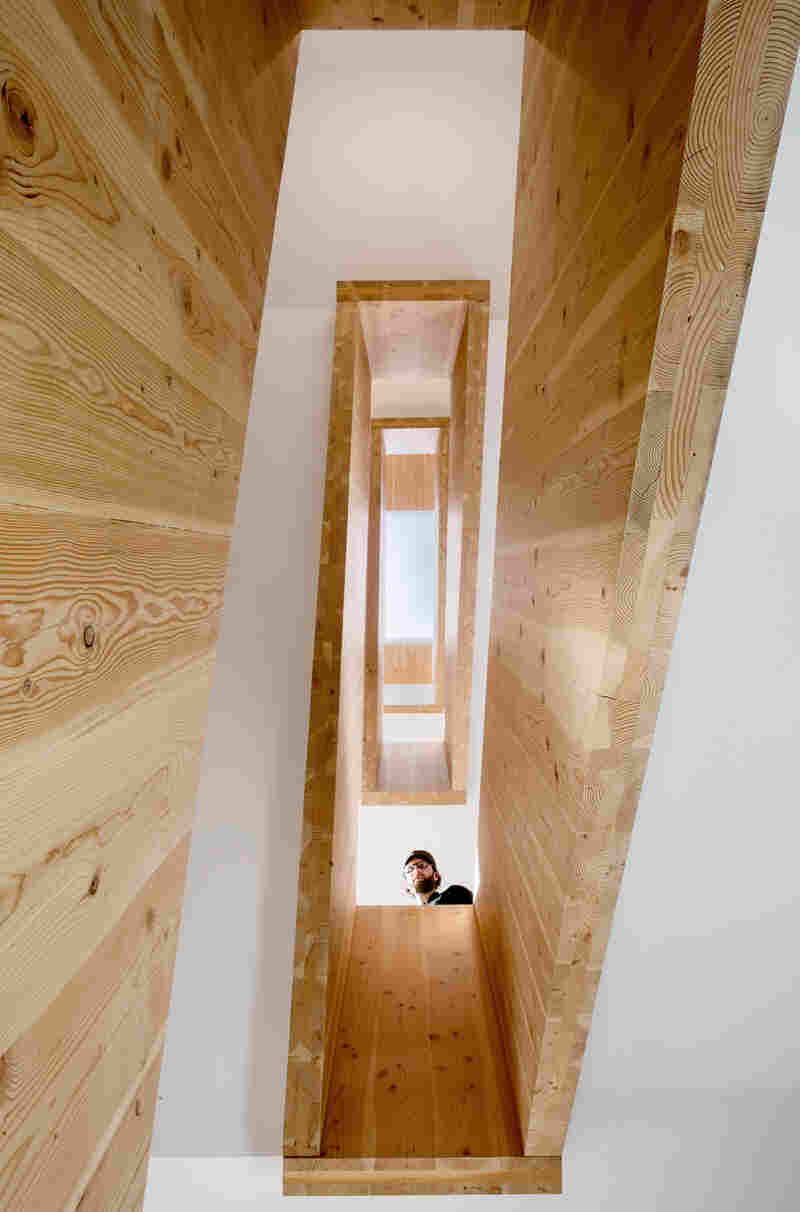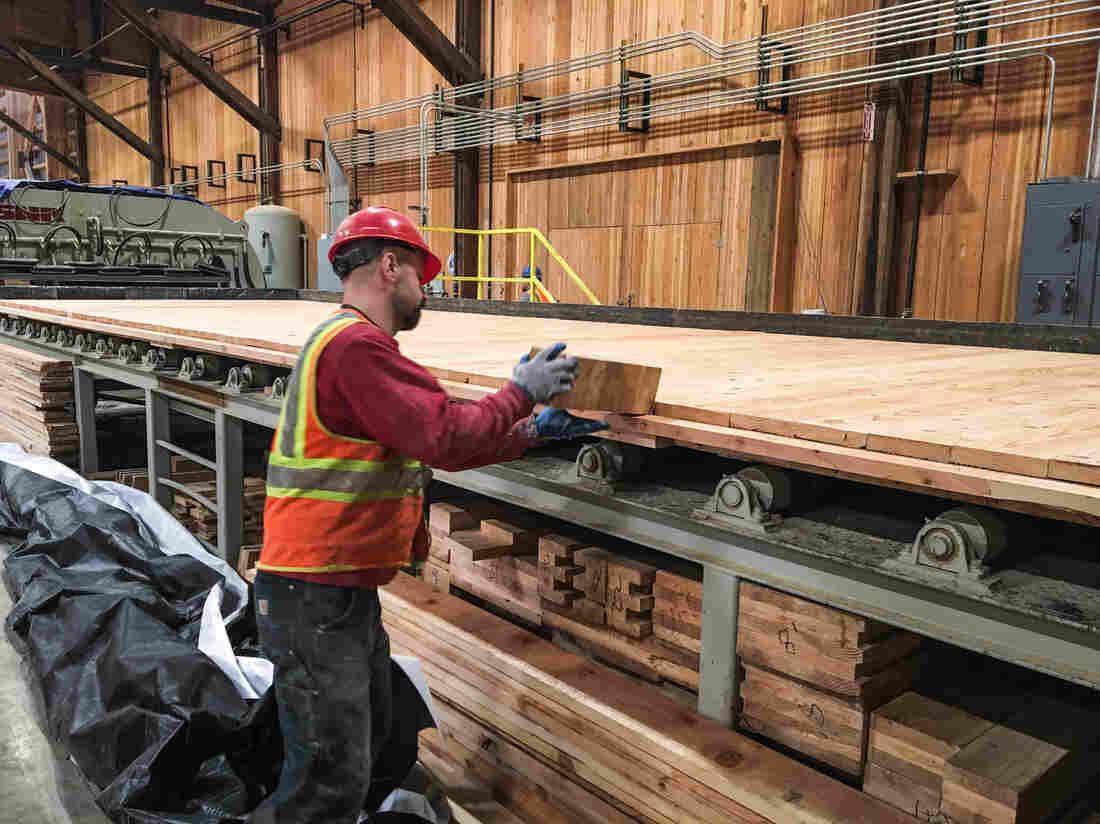Lever Architecture’s Framework exterior rendering, a 148-foot structure that, when completed, will be the tallest timber building in North America.
Courtesy of LEVER Architecture
hide caption
toggle caption
Courtesy of LEVER Architecture
Traditionally, states that rely on the timber industry, like Oregon, haven’t had much to cheer in the last 30 years. Modernization of mills, economic changes and huge declines in logging led to a long downturn in the industry. During last year’s presidential campaign, candidate Donald Trump promised to bring back timber in Oregon.
Some in the industry are hopeful, but others aren’t waiting. They’re moving ahead with innovations they hope are the key to survival.
Tall Timber
There’s a street corner in downtown Portland, Ore. where architect Thomas Robinson can stand today, and envision a dramatically different scene next year.
“What you’ll be seeing is a revolutionary 12 story, mass timber structure,” he says, “Really — a high rise timber building.”
Robinson’s firm Lever Architecture has designed a 148-foot structure that, when completed, will be the tallest timber building in North America.
Now you may be thinking — that’s a 148-foot match waiting to light.
But Robinson and his designers have studied how wood burns for four years. That knowledge helped them design a mass timber structure that meets the same fire standards as concrete and steel buildings. It’s designed to outperform its rivals in withstanding an earthquake. And then there’s the bonus of collaboration in a state, which like many others, is geographically and politically divided.
“It’s been a great way to connect urban Portland to rural Oregon,” says Robinson.
Crossing And Gluing And Building
The D.R. Johnson Lumber Company is about 200 miles south of Portland in the small town of Riddle, Ore. This is where they’ll make the key material for the Portland highrise, Cross Laminated Timber. CLT.
CLT is a pretty simple concept. You lay down a layer of boards length-wise, then a layer on top width-wise, then another layer the first direction. Up to 7 layers, all glued together, in one large panel. The criss-crossing creates a counter-tension that D.R. Johnson Chief Operating Officer John Redfield says makes the CLT panel both strong and flexible.
The panels are then used for easy-to-assemble construction.
Panels of cross laminated timber at DR Johnson. CLT is a pretty simple concept. You lay down a layer of boards length-wise, then a layer on top width-wise, then another layer the first direction.
Tom Goldman/NPR
hide caption
toggle caption
Tom Goldman/NPR
“The advantage of CLT is, we’re actually going to build your building right here in Riddle,” Redfield says. “[The material] is pre-designed, pre-engineered. They’ve got holes in them for mechanical and electrical and plumbing. They’ve got window holes. We load this on a truck in inverse order of how it’s going to be laid out on the job site, and we erect the building from the truck [in the right order].”
CLT has been made outside the U.S. for years and used around the world — including for refugee housing in Europe. When D.R. Johnson started making panels for sale three years ago, it was the first to do so in the country.
“We did, I think, all of us feel kind of a surge of excitement about the potential upside to it,” says company co-owner Valerie Johnson.
Innovating … Carefully
In 2013, Johnson went to a wood innovations meeting in Oregon. She says in such a tenuous industry as timber, it’s important to keep looking for ways to grow. At the meeting, she watched a presentation on CLT. The talk was compelling. The product was similar to some of the others her company made. So, Johnson decided to give it a go. Carefully.
D.R. Johnson started in 1951 and like many lumber companies in the state, it was hit by the timber downturn in the 1980s and 90s. The company shut three of its sawmills. Its workforce shrank by more than 350 people. Statewide, from 1980 to 2010, 300 mills closed, putting 30,000 people out of work.
So now, D.R. Johnson is going step by step. First they made a small CLT panel for testing; then they made panels to sell. Johnson says within the next six to 12 months, CLT production at her company should create 20 new jobs.
“I think the CLT market stands a really strong chance of being very successful here,” she says. “I hope I keep very healthy for a long time because I want to see these beautiful tall buildings built with wood.”
Workers at D.R. Johnson feed a layer of boards as part of the process of making CLT. They first made a small CLT panel for testing; then they made panels to sell. Johnson says within the next six to 12 months, CLT production at her company should create 20 new jobs.
Tom Goldman/NPR
hide caption
toggle caption
Tom Goldman/NPR
Others Innovating
Another company in Oregon is making big plywood panels for buildings.
And there’s more innovation to come.
CLT Stair at Albina Yard office building in Portland, Ore. The market for wood products is changing.
Jeremy Bittermann/Courtesy of LEVER Architecture
hide caption
toggle caption
Jeremy Bittermann/Courtesy of LEVER Architecture
“I’m comfortable that there are other manufacturers in Oregon that are looking closely at this,” says Geoff Huntington. He’s the Director of Strategic Initiatives for the College of Forestry at Oregon State University.
“I’m sure that you’ll see others following soon,” he says.
The market for wood products is changing.
“It’s a new frontier,” says Huntington. “We’ve got a building industry, both architects and developers, that are looking at wood in a new way and in different ways than they have before.”
Architects like Thomas Robinson, who’s working on the Portland high rise, like the look of wood. The rural-urban connection Robinson talks about also is part of the new allure. Huntington says it’s the same idea as the farm-to-table concept of embracing locally produced ingredients for food. In the case of wood, call it forest to framing.
For all that’s positive, Huntington acknowledges the growing markets for these new products aren’t going to cure all that ails Oregon’s timber industry. Trade issues and decades-long battles over harvesting trees still exist.
Another 80 miles south of D.R. Johnson, the battle toll is evident. Where not even innovation could help.
We’ve Done Everything We Could
On a recent day in Cave Junction, Ore., Jennifer Phillippi stepped around debris on the grounds of Rough & Ready Lumber Company. She co-owns the company with her husband Link — it’s been in her family since 1922. But it shut down last year and now it’s being torn down.
“Since they started dismantling it, I just haven’t come out here,” Phillippi says as she gazes at the rubble of what used to be a sawmill. “It makes me sad.”
Rough & Ready was heavily reliant on timber from federally owned lands. Those lands became practically untouchable to logging in the early 1990s after court decisions to protect the Northern Spotted Owl.
Link and Jennifer Phillippi, co-owners of Rough and Ready Lumber in Cave Junction, Ore. survey the remnants of their saw mill. The mill shut down for good in February 2016. What’s not been claimed in auction is being torn down.
Tom Goldman/NPR
hide caption
toggle caption
Tom Goldman/NPR
Jennifer Phillippi says her company tried to innovate its way through the downturn.
“Y’know we’re nimble, we’re small and we’ve done everything we could to sort of adjust,” she says.
They built a co-generation power plant. They upgraded equipment and made sawmill improvements. Ultimately, none of it mattered because they didn’t have enough logs to cut.
Eighty-five workers lost their jobs when Rough & Ready closed for good in 2016. The layoffs were another punch to an already dwindling local economy in a town of not quite 1,900 people. More services were cut. There’s one sheriff’s patrol, only during the day. Asked whether that makes him worry about his personal safety, former Rough & Ready employee Lonnie Adams, 60, says no.
Former Rough & Ready employee Lonnie Adams, 60, worked at Rough and Ready for more than 35 years.
Tom Goldman/NPR
hide caption
toggle caption
Tom Goldman/NPR
“I pack a gun everywhere I go,” Adams says. “I never used to.”
Cave Junction could be any small rural community marred by unemployment and the threat of crime. But longtime residents note, with pride, the citizen-organized group that tries to fill the law enforcement void with nightly car patrols; locals have fought to keep open the library. It’s communities like this where you’ll find hope in the new administration. Lonnie Adams remembers Donald Trump’s campaign promise to help Oregon’s timber industry. Adams thinks it could’ve saved Rough & Ready, where he worked for 35 years.
“I wish they would’ve held off [shutting down the company] a little longer until Trump got in office,” he says. “He probably will bring timber back because he’s a pretty smart man in my eyes. I wanted him for President. But, it’s too late for here.”
Balance Possible But Not Easy
Back up in Riddle, D.R. Johnson forges ahead with its innovative CLT production. Unlike Rough & Ready, D.R. Johnson hasn’t been so reliant on federal forests. But it still feels the pinch.
“We scrape for the logs for this old mill here, every month,” Johnson says. “Our guys have to hustle to find them.”
D.R. Johnson’s Steve Allen uses a block of wood to make sure boards are aligned properly before the CLT panel enters the pressing machine at far left.
Tom Goldman/NPR
hide caption
toggle caption
Tom Goldman/NPR
Johnson and others in the industry talk about increasing timber harvests without over harvesting. Some environmental groups remain wary and continue to block timber sales, mostly on federal lands, with lawsuits. While the battle continues, at least one prominent forest ecologist says it doesn’t have to.
“Could you increase the timber harvest from the federal lands in a way that would be ecologically as well as socially responsible?” asks Jerry Franklin of the University of Washington. “The generic answer to that is absolutely — yes.”
But the specifics, he says, get very complex. And politicized. At least one bill that attempted to hit the sweet spot between harvesting and conservation, remains stalled in Congress.
Meanwhile, the quest for timber innovation continues. Groundbreaking on the nation’s tallest timber high rise building, is expected this summer in Portland.
Let’s block ads! (Why?)


